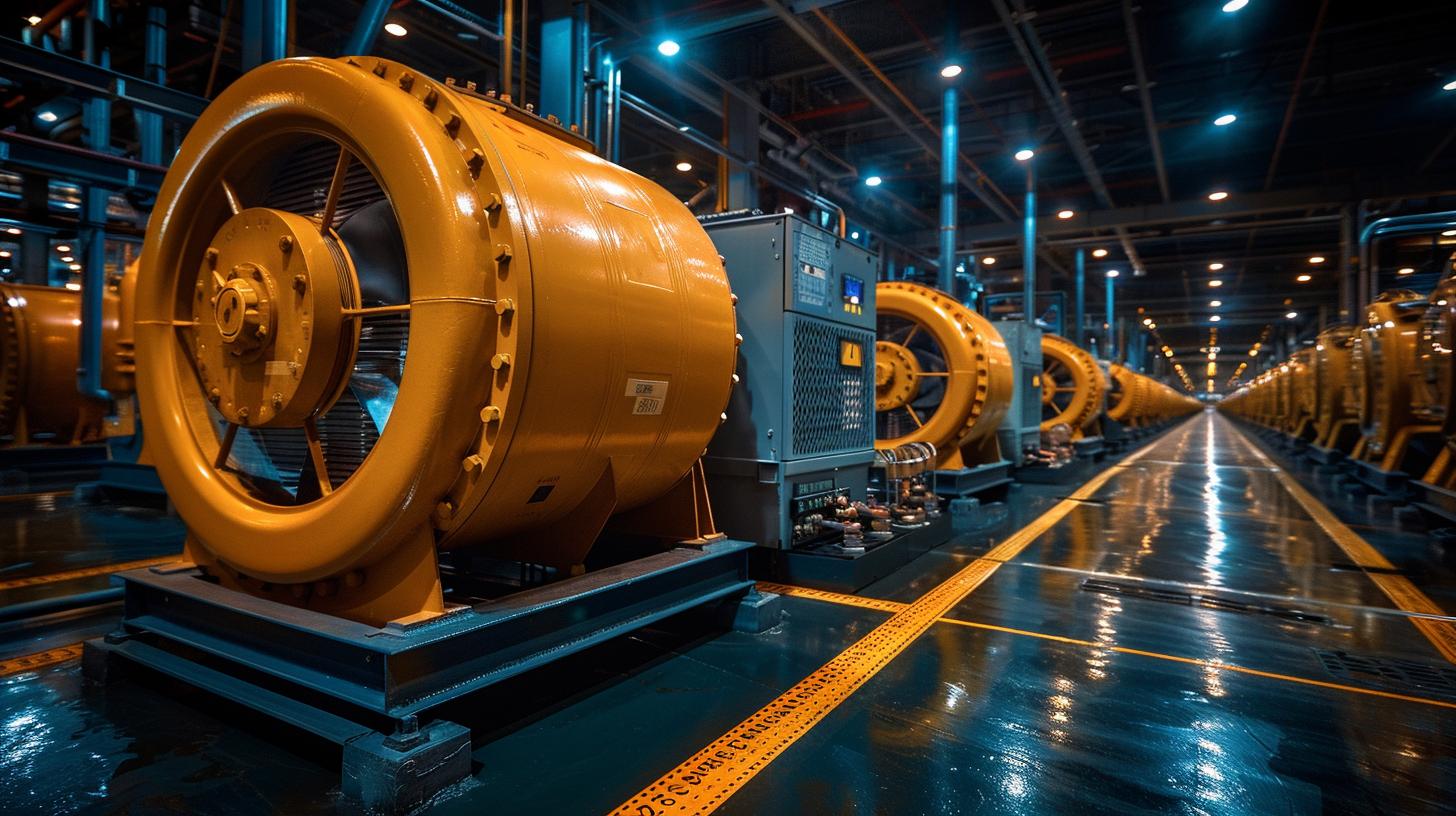Today, environmental protection and sustainability are not just ethical matters, but a global necessity. Hence, the rise of green cryptocurrency mining practices, which is reshaping the energy-consuming industry of cryptocurrency extraction in an eco-friendly direction. This article focuses on Green Mining Data AirFlow’s commitment to this sustainable cause.
Cryptocurrency has grabbed the attention of investors worldwide due to its dynamic nature and potentially lucrative returns. Blockchain technologies that underpin cryptocurrencies are also gaining popularity across numerous industries. These digital currencies provide promising financial opportunities, as well as technological advancements like smart contracts and decentralized finance. However, alongside these revolutionary possibilities come considerable concerns about their environmental impact.
The process of creating or ‘mining’ cryptocurrencies necessitates massive amounts of computing power. This usually leads to high consumption of electricity – most of which originate from non-renewable sources – resulting in substantial carbon footprints left by these activities.
With increasing global awareness about climate change and the need for sustainable practices in all industries, there is a rising demand for more eco-friendly methods within the realm of cryptocurrency extraction. It’s against this backdrop that we introduce Green Mining Data AirFlow – a pioneering entity steadfast in its commitment to implementing sustainable measures in the arena of cryptocurrency mining.
Understanding Cryptocurrency Mining and Its Environmental Consequences
The foundation of cryptocurrency’s appeal lies in its decentralized and secure nature which is ensured through a process known as “mining”. Mining refers to the validation of new transactions and adding them into the blockchain – a public ledger. The process entails combining chunks of transactions (blocks) and solving complex mathematical problems by utilizing high-powered computers. These puzzles are designed so that their solutions demand a significant amount of computational power, hence consuming substantial amounts of energy.
Mining cryptocurrencies, particularly Bitcoin, can have severe environmental consequences primarily due to the sheer electricity consumption it necessitates. Given the increasing popularity and value of Bitcoin, more and more ‘miners’ are incentivized to participate in securing the network thereby further increasing competition as well as electricity consumption.
Beyond just huge electricity bills for miners, this leads to substantial carbon emissions contributing negatively towards climate change. In fact, according to Digiconomist’s Bitcoin Energy Consumption Index, Bitcoin’s annual energy consumption surpasses that of some entire nations such as The Netherlands or Argentina.
Surging concerns have arisen regarding these environmental implications of cryptocurrency mining leading to calls for more sustainable alternatives. Embracing green cryptocurrency mining practices stands out as an essential partmoving forward for the industry’s sustainability-savvy image while reducing its carbon footprint substantially.
| Cryptocurrency | Annual Energy Consumption (Twh) |
|---|---|
| Bitcoin | 36 |
| Ethereum | 49 |
This table illustrates annual energy consumption equivalent in Terawatt hours (TWh) for two major cryptocurrencies – Bitcoin and Ethereum.That equates to an immense volume carbon dioxide (CO2) emission annually considering typical emission factors associated with large-scale electricity production. These figures underline the urgent need to adapt green and renewable energy for cryptocurrency mining.
The Green Mining Initiative
The contemporary world is witnessing the dawn of cryptocurrency, a digital revolution that is both fascinating and alarming. Cryptocurrencies like Bitcoin have taken the world by storm. However, the alarm stems from the steep environmental cost associated with their production. Green Mining Data AirFlow looks to mitigate these damaging environmental consequences through introducing greener practices in mining.
Green Mining Data AirFlow was founded with the aim to alleviate environmental concerns arising out of cryptocurrency mining whilst ensuring efficacy and financial viability. The company recognizes that it is not enough just to keep up with technological advancements but also integrate them responsibly with respect for our environment. With this perspective, its mission is to make effective use of renewable resources and employ power-efficient hardware without compromising on profitability, a pledge towards green cryptocurrency mining practices.

Adherence to such sustainable methods can significantly minimize energy consumption associated with blockchain computations required in crypto mining process, thereby reducing carbon footprints substantially. Moreover, by leading responsible mining operations, Green Mining Data AirFlow intends to set an industry benchmark motivating other players in the field also to embrace greener solutions moving beyond unsustainable methods.
| Aspect | Description |
|---|---|
| Company | Green Mining Data AirFlow |
| Mission | Sustainable Crypto-mining using renewable resources and efficient hardware. |
| Influence | Setting industry benchmarks; inspiring others in the field. |
Green Mining Data AirFlow’s Eco-Friendly Technologies and Strategies
Eco-Friendly Technologies and Tools Deployed
Green Mining Data AirFlow (GMAD) utilizes a plethora of technologies to sustainably mine cryptocurrencies. The process begins with data center cooling. GMAD’s innovative algorithm allows for optimized energy usage by calculating the exact cooling power needed at any given moment, rather than continuously pumping out cooled air. Besides having a massive positive environmental impact, this dynamic approach also reduces operational costs on air conditioning.
The company has further reduced its energy consumption via cloud-based mining strategies and virtual server utilization creating arguably one of the most powerful yet eco-friendly platforms operating today. Leveraging distributed cloud resources propels Green Mining Data AirFlow to achieve better processing efficiency and lower energy consumption compared to traditional mining processes.
Strategies Implemented
On a strategic level, GMAD employs some unique methods that greatly enhance its green cryptocurrency mining practices. It only sources electricity from renewable sources, such as hydropower or solar power. Additionally, rigorous energy audits are performed consistently to ensure exemplary standards in energy efficiency are maintained throughout their operations.
Intricately heating parts of systems which need it most while keeping others cool limits unnecessary waste. This way, no excess heat is produced and consumed power corresponds directly with computational needs. By embracing sustainability as part of their core strategy, Green Mining Data AirFlow exhibits an unwavering commitment towards environmental responsibility.
Innovations in Crypto-Mining Practices
Green Mining Data AirFlow is not just focused on improving existing processes but also heavily invests in exploring new and revolutionary ways for sustainable crypto-mining practices. One notable example is the conversion of excess heat generated during the mining process into electricity which can be fed back into the system, thereby creating a cycle of renewable energy.
Moreover, they are actively researching more efficient algorithms that require less computational power hence reducing excessive energy demand typical within cryptocurrency mining activities. By being at the forefront of sustainable mining, Green Mining Data AirFlow is shaping how cryptocurrencies are mined, pushing the industry towards less resource-intensive techniques and endorsing broader ecological accountability.
Why Sustainability Matters in Cryptocurrency Mining
Adopting green cryptocurrency mining practices carries significant potential benefits, both for individual miners and for the larger societal perception of cryptocurrencies. After all, the environmental challenges associated with current, non-green mining practices present significant ethical concerns that can threaten cryptocurrencies’ public acceptance.
From a financial perspective, sustainable cryptocurrency extraction can lead to long-term savings. Traditional cryptocurrency mining requires considerable energy expenditure due to the complex computations involved in the process. This results in high energy costs, which eventually take a toll on miners’ profitability. By contrast, practicing green cryptocurrency mining is oriented towards finding solutions that reduce power usage without compromising output. Thus, their adoption could drastically cut down overheads associated with energy consumption:
- Investment in energy-efficient hardware
- Utilization of renewable energy souces
- Designing eco-friendly cooling methods
- Incorporation of optimal algorithm solutions
Green Mining Data AirFlow demonstrates how it’s possible to strike such a balance while remaining competitive and profitable within the industry.

Additionally, sustainable practices improve the reputation and reception of cryptocurrencies amongst society at large. The general public has continued growing more conscious about environmental conservation over recent years and as such this trend extends into their interactions with technology too – including cryptocurrencies.
So lessening cryptocurrency mining’s detrimental impact on the environment makes them way more attractive and savory to morally-minded investors and consumers alike. It’s thus clear that maximising sustainability offers a viable path forward for entities interested in pursuing ethical best practices while leveraging innovative tech – offering recourse for building a greener future.
Future of Cryptocurrency Mining
Trending Toward Sustainability in Cryptocurrency Mining
With the growing movement towards sustainable business practices, it is well to note that eco-friendly alternatives are being developed in all industries, including cryptocurrency mining. This shift toward green cryptocurrency mining practices is not driven solely by environmental concerns, but also by financial implications. The consumption of less power results in lower operational costs which represent significant potential savings for institutions in the long run.
Green Mining Data AirFlow stands at the forefront of this transition towards greener cryptocurrency extraction. Following extensive research and development efforts, the organization has committed itself to using only renewable sources of energy in its operations. This pursuit does not stop here; it also includes ongoing improvements and adaptations to guarantee that their processes remain as efficient and sustainable as possible.
Green Mining Data AirFlow’s Roadmap for a Green Future
Green Mining Data AirFlow envisions a future where green cryptocurrency mining practices are not just an option but become industry-standard. To bring this vision into reality, the company plans several initiatives aimed at transforming how cryptocurrencies are mined. These include an expansion of their research and development programs focused on finding more energy-efficient ways for crypto mining as well increasing investments in renewable energy resources.
The company is also intent on sharing its learning with the broader cryptocurrency community and leading discussions around sustainability within digital currencies. This approach emphasizes that sustainability is not just about adopting green technologies, but also about fostering a culture change within communities where these technologies are taking root.
The Role of Stakeholders: From Miners to Investors
Transitioning to greener cryptocurrency mining methods will require concerted efforts from all stakeholders involved, from individual miners to institutional investors. Green Mining Data AirFlow recognizes this need for collective responsibility and encourages everyone in the community to do their part.
For miners, this means choosing green companies like Green Mining Data AirFlow for establishing their operations or participating in pools. For institutional investors, this could entail investing in companies that are committed to having a green footprint in the blockchain world. By supporting businesses like Green Mining Data AirFlow, which prioritize sustainable practices, stakeholders can effect significant environmental changes while also availing themselves of potential energy-related savings.
In providing a greener approach to crypto mining, Green Mining Data AirFlow aims to redefine conventional practices and show that profitability doesn’t have to come at the cost of sustainability.
Conclusion
As we conclude, it is necessary to recapture just how critical the issues in cryptocurrency mining are. The sheer amount of energy consumption and carbon emissions associated with this digital enterprise have stirred concerning debates around its environmental impact.
The sector’s exponential growth necessitates immediate intervention, directing industry focus towards greener practices. While there are many parties involved in this space, all eyes should be on Green Mining Data AirFlow – the harbinger of change that seeks to reinvent the narrative around cryptocurrency extraction.

Green Mining Data AirFlow’s pioneering work presents a practical solution to shape sustainable future for cryptocurrency mining. Through adopting advanced eco-friendly technologies and green strategies, Green Mining Data AirFlow exemplifies the possibility of achieving an efficient yet environmentally sensitive mining operation. Its commitment goes beyond mere lip service; by employing renewable energy sources and optimizing energy utilization at each stage of extraction, they’re effectively minimizing their carbon footprint, setting a model for others to follow.
This commitment by Green Mining Data AirFlow should also serve as a rallying call for other industry players, miners, investors, even casual enthusiasts – transforming conventional views on what it means to mine cryptocurrencies. Adopting green cryptocurrency mining practices is not just about preserving our environment; it also presents long-term financial benefits and sets cryptocurrencies on a more socially acceptable footing.
It is our collective action today that will determine whether the vast potential latent in cryptocurrencies can be fully realized while ensuring we leave an inhabitable planet for future generations.
Frequently Asked Questions
Is Crypto Mining Eco-Friendly?
Crypto mining is often criticized for being harmful to the environment due to the significant amount of energy it requires. The global network that enables transactions and the creation of new units of cryptocurrencies involves complex calculations which heavily rely on electricity produced through carbon-intensive methods.
However, some mining operations are shifting towards cleaner, renewable sources of energy in an effort to reduce their environmental impact.
What Renewable Energy Is Used for Crypto Mining?
A variety of renewable energy sources are used for crypto mining. Some miners use solar power, harnessing the energy from sunlight and converting it into electricity to power their operations.
Others might use wind power or hydroelectric power, relying on natural, constantly renewing forces like wind and running water to generate energy. Geothermal power is another alternative source utilized in some regions where geothermal activity is high.
Is Bitcoin Mining Green?
Green Bitcoin mining refers to the practice of using renewable and sustainable energy sources to carry out computational tasks necessary for producing Bitcoin. However, studies suggest a considerable portion of Bitcoin mining still relies on non-renewable, carbon-intensive energy sources, causing significant CO2 emissions and thus contributing to global warming.
Though there has been recent progress with more miners turning toward sustainable solutions, classifying Bitcoin mining as completely green is not possible at this point.
What Is the Greenest Cryptocurrency?
The greenest cryptocurrency varies based on how they are generated or mined and what type of energy is used in the process. For example, Nano claims to be eco-friendly because its protocol design doesn’t require high-energy consumption for transaction validations or maintaining its blockchain architecture since it uses a block-lattice structure instead.
What Is the Most Environmentally Friendly Mining?
Environmentally friendly mining primarily depends upon the utilization of renewable energy sources like solar power, wind turbines or hydroelectric generators, along with efficient equipment designs that minimize resource consumption. Therefore, no fixed method can be crowned as the most environmentally friendly overall—it largely depends on individual practices.
Does Crypto Mining Pollute?
Yes, crypto mining can cause pollution due mainly to its enormous electricity demands which often come from fossil fuel-based power plants. Emissions from these sources contribute to air pollution and the global climate crisis. Furthermore, the electronic waste produced by obsolete mining equipment also represents a significant environmental concern.
Is Mining Bad for the Environment?
Traditional forms of mining, such as gold or coal, can be significantly harmful to the environment due to habitat destruction, water contamination and contributions to greenhouse gas emissions. Similarly, digital currency mining also poses environmental threats because of its high electricity consumption, often derived from non-renewable sources, and potential e-waste production.
What Percent of Bitcoin Mining Is Renewable?
The percentage of Bitcoin mining that is powered by renewable energy fluctuates over time and depends on various factors including geographical location and available resources. According to Cambridge Centre for Alternative Finance’s 3rd Global Cryptoasset Benchmarking Study in October 2020, it estimated that approximately 39% of total Bitcoin mining consumes energy from renewable sources.




